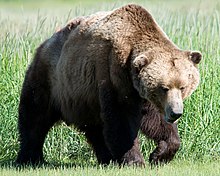Alaska Peninsula brown bear
| Alaska Peninsula brown bear Temporal range: – Recent |
|
|---|---|
 |
|
| Alaska Peninsula brown bear (U. arctos horribilis) in Hallo Bay, Katmai National Park, Alaska | |
| Scientific classification | |
| Kingdom: | Animalia |
| Phylum: | Chordata |
| Class: | Mammalia |
| Order: | Carnivora |
| Family: | Ursidae |
| Genus: | Ursus |
| Species: | U. arctos |
| Subspecies: | U. arctos horribilis |
The Alaska Peninsula brown bear is any member of the grizzly bear (Ursus arctos horribilis) that lives in the coastal regions of southern Alaska. Alaska Peninsula brown bears are a very large brown bear subspecies, usually ranging in weight from 800 to 1,200 pounds (363 to 544 kg). They are found in high densities along the southern Alaskan coast due not only to the large amount of clams and sedge grass but also to the annual salmon runs; this allows them to attain huge sizes, some of the biggest in the world. They may gather in large numbers at feeding sites, such as Brooks Falls and McNeil Falls, both in Katmai National Park near King Salmon.
There is debate as to if Alaska Peninsula brown bears should be referred to as "grizzlies" along with all other North American subspecies of the brown bear. There is confusion experienced when referring to inland and coastal ones separately, but biologists still maintain that coastal ones are truly brown bears. However, it is considered correct to place all North American members of U. arctos in the subspecies horribilis except the giant Kodiak bears of Kodiak Island. To avoid confusion, many simply refer to all North American members, including Kodiaks, as "grizzly bears."
Prized by hunters for their skulls and hides, up to 500 of Alaska's 1,500 brown bears killed yearly by hunters come from the Alaska Peninsula. To hunt this large bear, hunters must follow a variety of regulations, including bear bag limits, hunting fees, and proper rifles.
The Alaska Peninsula brown bear's name most likely arose because, until 1975, they were considered a different species from the inland grizzly bear. They were never considered closer to European brown bears than inland grizzlies, but were given a different name, due to the size and color differences of coastal browns and inland grizzlies. From 1975 onward, they were considered to be the same species, but coastal ones retained the name "brown bear."
...
Wikipedia

